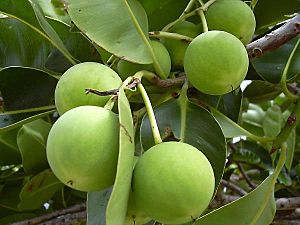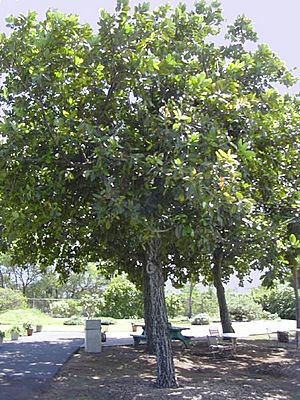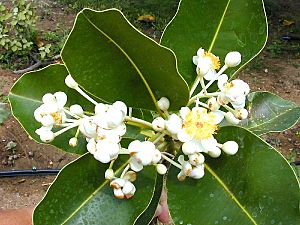Tamanu oil facts for kids
Tamanu oil is a special oil pressed from the nuts of tropical trees, usually called Calophyllum inophyllum. These trees grow in warm places. The nuts give a lot of greenish-yellow oil, but you can't eat it. Tamanu oil first came from Polynesia, where it's still very important to the local people. Today, it's mostly used in skin care products. This oil has been used for its healing properties and even as a type of fuel. It's full of good stuff like antioxidants and can help protect skin from the sun. Tamanu oil can help heal wounds and fight germs, but it needs to be used carefully because too much can be harmful to cells.
Contents
What is Tamanu Oil Used For?
The seeds of the tamanu tree give a thick, dark green oil. People have used this oil for medicine or as a hair treatment.
Tamanu Oil as Fuel
The oil from C. inophyllum seeds can be turned into biodiesel. This type of fuel meets important standards in places like the United States and the European Union. One tree can produce about 11.7 kilograms of oil, which means a large area of trees can make a lot of fuel!
In the past, people in the Philippines used tamanu oil to light their lamps at night. This use became less common when kerosene and later electricity became available. During World War II, it was even used to power radios! A farmer in Tamil Nadu, India, successfully used this oil as biodiesel to run his water pumps.
Tamanu Oil for Skin and Health
In South India, tamanu oil is used to help with skin diseases and to ease pain from rheumatism. It might also have been used to make cloth waterproof or as a type of varnish. An extract from the fruit was once used to make a brown dye for cloth. You can even use the oil to make soap.
On many South Sea islands, tamanu oil is used as a pain reliever for things like sciatica (nerve pain) and rheumatism. It's also used to help heal ulcers and bad wounds.
Traditionally, people put the oil on their skin to treat many injuries, including burns, scars, and infected wounds. It's also used for skin problems like dermatosis, hives, and eczema. Studies have shown that tamanu oil is safe to use on the skin. It can even help skin cells heal faster.
Tamanu oil is also good at fighting bacteria that cause acne. Recent studies suggest that tamanu oil could be a promising source for new antibiotics, especially to fight germs that are hard to treat with regular medicines.
Other Names for Tamanu Oil
Tamanu oil has many different names around the world! Some of these include:
- Beauty leaf oil
- Calophyllum inophyllum seed oil
- Kamani oil
- Dilo oil
- Foraha oil
- Alexandrian laurel oil
- Poon oil
- Nyamplung oil
- Domba oil
- Honne oil
- Undi oil
- Pinnai oil
- Fetau oil
- Punnai oil
- Daok oil
- Pinnay oil
- Kamanu oil
- Bitaog oil
- Tamanu nut oil
- Punna oil
- Punnaga oil
- Fetaʻu oil
- Palo maria oil
- Ballnut tree oil
- Ballnut oil
- Btaches oil
- Beach calophyllum oil
- Mù u oil
Here are some names in different languages:
- Chamorro: daok
- English: Beauty leaf, Alexandrian laurel
- Hindi: सुलतान चम्पा (sultan champa)
- Indonesian: nyamplung
- Japanese: テリハボク (terihaboku)
- Kannada: ಸುರಹೊನ್ನೆ (surhonne)
- Konkani: उंडी (undi), उंगम (unga)
- Malayalam: പുന്ന (punna)
- Marathi: सुरंगी (surangi), पुन्नाग (punnag), उंड (unda), उंडी (undi)
- Oriya: tungakesara, ପୋଲାଙ୍ଗ (Polang)
- Sanskrit: काम्बोज (kambojh), कुम्भीक (kumbhikh), नाग चम्पा (naag champa), नागपुष्प (nagapushpah)
- Tamil: புன்னை (punnai)
- Telugu: punnaga, నమేరువు (nameruvu), పొన్న (ponna)
- Tulu: ponne
- Urdu: سرپن (surpun)
- Vietnamese: dầu mù u
Tamanu Fruit and Seeds
The tamanu tree produces fruit twice a year, usually in May and November. The fruit, sometimes called a "ball nut," is round and green. It's about 2 to 4 centimeters wide and has one large seed inside. When the fruit is ripe, it becomes wrinkled and changes color from yellow to brownish-red. A fresh fruit weighs about 9 to 16 grams, but after drying, it weighs around 4 grams. People collect the ripe fruits from under the tree or pick them by climbing the tree.
The Kernel
Inside the dry fruit is the kernel, which makes up about 43–52% of the fruit's weight. The kernel is about 1.5 centimeters wide and has two layers of seed coat around it. When fresh, the kernel contains a lot of oil (55–73%) and some moisture.
How Tamanu Oil is Made
To get the oil, the seeds are first shelled (decorticated). This can be done using wooden mallets or special machines. Then, the kernels are pressed, often using traditional wooden or stone presses.
What's in Tamanu Oil?
Tamanu oil is usually bluish-yellow to dark green and feels thick. It can have a strong, unpleasant taste and smell because it contains some natural resins. These resins can be removed by refining the oil. The oil is made up of several important fatty acids, including oleic, linoleic, stearic, and palmitic acids.
Fatty Acids in Tamanu Oil
| Fatty acid | Percentage |
|---|---|
| Palmitic acid | 14.8-18.5 |
| Stearic acid | 6.0-9.0 |
| Oleic acid | 36-53 |
| Linoleic acid | 16-29 |
| Erucic acid | 2.5-3.5 |
Other things found in tamanu oil include special compounds like calophyllolide, friedelin, and different types of terpenes. It also contains benzoic acid and other helpful substances.





